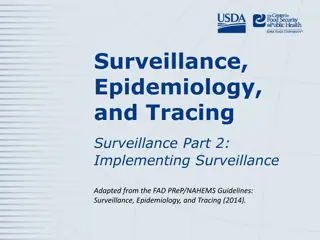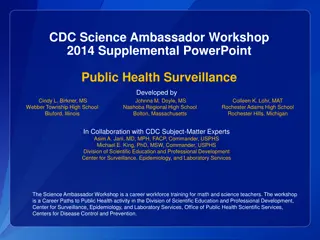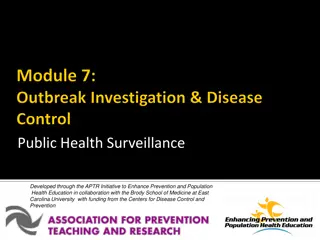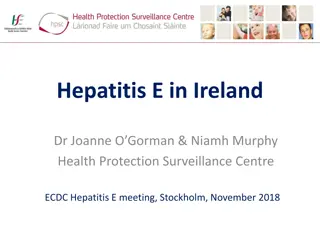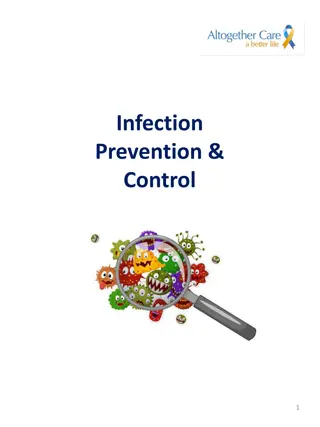BTH/OTH Radar and Maritime Surveillance Radar Overview
The article discusses BTH/OTH radar systems and maritime surveillance radars, exploring their functionalities, benefits, drawbacks, and real-world examples. It delves into the working principles of OTH radar, showcasing how it operates through the ionosphere. Additionally, it covers the concept of m
5 views • 12 slides
Injury Surveillance in Scotland: Importance and Implementation Overview
Scotland's Public Health body, Public Health Scotland, leads efforts in injury surveillance to prolong healthy life, prevent disease, and promote health. Long-term investment in prevention involves various sectors. Injury surveillance is crucial as it helps manage and prevent injuries, with coded da
4 views • 24 slides
Understanding Infection: Causes, Signs, and Nursing Management
Learn about the definition of infection, common causes, general and specific signs and symptoms, nursing assessment for foot ulcers and pressure injuries, as well as nursing interventions for infection prevention and management. Dive into the stages of infection, general and specific signs and sympt
0 views • 24 slides
Implementing Surveillance in Epidemiology: Methods and Considerations
This presentation outlines sampling methods and considerations for implementing surveillance in epidemiology. It covers aspects such as sample types, sizes, random vs targeted sampling, and the comparison between the two approaches. The content provides insights into the practical aspects of surveil
1 views • 24 slides
Nutrition Surveillance in Kenya: Workshop Insights and Challenges
The ongoing activities of the Nutrition Surveillance Learning Network in Kenya, presented by Samuel Murage, shed light on malnutrition statistics, micronutrient deficiencies, breastfeeding trends, vitamin A supplementation, and IFAs for pregnant women. The presentation also discussed information sys
0 views • 17 slides
Introduction to Public Health Surveillance
Public health surveillance is essential in monitoring and analyzing health concerns that affect the entire nation. From infectious disease outbreaks to chronic illnesses and environmental disasters, public health aims to improve overall health and well-being. This presentation serves as an informati
0 views • 19 slides
Urban Surveillance and Health Reporting System in Bangalore Model
Urban surveillance under the Integrated Disease Surveillance Program (IDSP) in Bangalore, Karnataka, involves monitoring health facilities, online reporting of diseases, and coordinated response actions. The system includes reporting from hospitals and labs, real-time alerts, and tracking preventive
0 views • 7 slides
Optimizing Early Infant HIV Diagnosis Through Point-of-Care Testing Post-Market Surveillance
Optimizing early infant HIV diagnosis is crucial for public health. Post-market surveillance ensures the safety of medical devices, balancing therapeutic advancements with public health safeguards. The WHO's Medical Device Unit prioritizes access to devices in low-resource settings, emphasizing diss
0 views • 16 slides
Collaboration for Efficient COVID-19 Surveillance: NNDSS Case Notifications
Center for Surveillance, Epidemiology, and Laboratory Services is working with Michele Hoover's team to streamline the COVID-19 National Notifiable Diseases Surveillance System (NNDSS) for jurisdictional efficiencies. The timeline showcases the progression from the first CDC-confirmed case to the de
2 views • 20 slides
Enhancing AFP Surveillance for Polio Eradication in East Africa
This presentation discusses the importance of Acute Flaccid Paralysis (AFP) surveillance in detecting poliomyelitis cases, with a focus on the National Stop Transmission of Polio Mission in Kasese District, Uganda. The goal is to eradicate poliovirus through strategies such as immunization campaigns
0 views • 12 slides
Role of Rapid Diagnostic Test for Measles in Global Surveillance
Laboratory-based surveillance is crucial for monitoring and controlling measles outbreaks. The development of new tools like rapid diagnostic tests (RDTs) for measles diagnosis can revolutionize surveillance efforts. Challenges in introducing new diagnostics are discussed, along with the importance
0 views • 30 slides
Harnessing Syndromic Surveillance Systems for Climate-Related Outcomes
Utilizing syndromic surveillance systems can provide valuable insights into the impact of climate change on health outcomes. This document aims to guide users on identifying outcomes, creating case definitions, combining data sources, and engaging with partners for effective climate and health surve
1 views • 28 slides
Comprehensive Guide to Infection Prevention and Control in Healthcare Facilities
This comprehensive guide outlines the objectives, structure, responsibilities, common sources of infection, and principles of infection prevention and control in healthcare facilities. The program aims to minimize the risk of healthcare-associated infections, enhance healthcare worker adherence to I
0 views • 55 slides
Comprehensive Overview of Hospital-Acquired Infection Surveillance System
Surveillance systems like HAI surveillance play a crucial role in monitoring and managing hospital-acquired infections (HAIs) by providing baseline rates, comparing data, and identifying problem areas. This system covers various types of infections such as CAUTI, CLABSI, VAE, and SSI, with specific
0 views • 20 slides
Enhancing Infection Surveillance in Long-Term Care Facilities
Explore the importance of surveillance, new definitions, implementation strategies, and outcomes in long-term care settings. Understand why surveillance is essential, how it is performed, population assessment, various surveillance approaches, and selection criteria for processes and outcomes.
0 views • 50 slides
Understanding Standardized Infection Ratio (SIR) in Healthcare-Associated Infections
The Standardized Infection Ratio (SIR) is a key measure used to monitor healthcare-associated infections (HAIs) at different levels. It compares observed HAIs with predicted values based on specific risk factors. An SIR > 1 indicates more infections than predicted, an SIR = 1 means observed equals p
0 views • 19 slides
Post Market Surveillance Procedures in Indonesia
Post-market surveillance of medical devices in Indonesia is overseen by the Surveillance Directorate of Medical Device and Household Health Supplies. Manufacturers must adhere to ASEAN guidelines and report adverse events through online systems. The country has specific regulations and requirements
0 views • 10 slides
Understanding the Epidemic of C. Difficile Infection: Insights and Implications
C. Difficile infection is a growing concern, with a significant impact on public health in the United States. High rates of infection and mortality, particularly among the elderly, highlight the urgent need for effective prevention and management strategies. The burden of C. Difficile infection exte
0 views • 59 slides
Texas Influenza Surveillance Overview
In this overview, we delve into the details of influenza surveillance in Texas, covering various aspects such as flu testing, notifiable conditions, and the 2022-2023 flu season review. The information provided includes surveillance structures, reporting requirements, and the vital role of testing i
0 views • 17 slides
Strategies for Overcoming Surveillance Challenges During the 2014 Measles Outbreak in the Philippines
The Philippines faced surveillance challenges during the 2014 measles outbreak, including manpower capacity, logistics, data management, and reporting mechanisms. Key interventions involved activating surge capacity, conducting orientations, procuring specimen kits, and promoting efficient data coll
0 views • 18 slides
Comprehensive Overview of FinSpy Surveillance System
FinSpy is a powerful tool designed for Law Enforcement and Intelligence Agencies to remotely monitor computer systems. It provides access to online communication platforms, internet activities, stored data, surveillance devices, and more. The system components include FinSpy Agent with graphical use
0 views • 190 slides
Infection Guidelines for Data Entry Scenarios
Guidelines for entering different infection scenarios into a database, including pre-implant infections, colonization cases, and handling multiple organisms in cultures. Clear instructions on what constitutes a major infection adverse event and how to accurately document various infection situations
0 views • 18 slides
Developing a Surgical Site Infection Bundle for Improved Patient Outcomes
Developing a comprehensive Surgical Site Infection (SSI) bundle to reduce infection rates, including interventions like preoperative chlorhexidine baths, standardized antibiotic protocols, and targeted prophylactic measures. By implementing these strategies, the aim is to lower infection rates below
0 views • 24 slides
Trends in Parasitic Copepod Infection Among Juvenile Salmonids in WVP Reservoirs Study
Study conducted by the Oregon Department of Fish and Wildlife researchers to investigate trends in parasitic copepod infection among juvenile salmonids in WVP reservoirs. The study focuses on the prevalence and intensity of infection on the gills, comparing infection levels between stream-rearing an
0 views • 12 slides
Understanding Surveillance in Biodiversity Conservation
Surveillance plays a crucial role in biodiversity conservation by aiding in the early detection of new incursions and invasive species. It helps in limiting the spread of threats, identifying priorities for action, and assessing prevention system effectiveness through passive and active surveillance
0 views • 24 slides
Understanding Public Health Surveillance for Population Health
Public Health Surveillance is a vital process for systematically collecting, analyzing, and interpreting health data to inform public health practices. This crucial initiative, developed through the APTR in collaboration with the Brody School of Medicine at East Carolina University, focuses on enhan
0 views • 40 slides
Hepatitis E Surveillance and Notifications in Ireland
The surveillance and notification of Hepatitis E cases in Ireland have been detailed, including the introduction of universal blood donor screening, notifiable disease status, and enhanced surveillance measures. The data shows trends in notifications, blood donor screening results, clinical cases, a
0 views • 13 slides
Comprehensive Guide to Infection Prevention and Control
Understanding the essentials of infection prevention and control is crucial in healthcare settings. This guide covers key topics such as basic principles, standard precautions, specific infections, surveillance, and prevention methods. It explores the chain of infection, factors making individuals s
0 views • 65 slides
Understanding Congenital Zika Virus Infection Evaluation and Reporting
This module provides comprehensive information on evaluating, testing, and reporting cases of congenital Zika virus infection. Learners will gain insights into guidelines, case definitions, and the importance of accurate reporting for better surveillance. Access to updated resources and the impact o
0 views • 34 slides
Guidelines for Suspecting and Managing 2019-nCoV (COVID-19) Infection
Guidelines provided by the Ministry of Public Health in Lebanon highlight the criteria for suspecting a 2019-nCoV (COVID-19) infection, including illness onset and exposure factors. It outlines symptoms to look for, such as fever and respiratory issues, as well as exposure scenarios like travel to C
0 views • 23 slides
Importance of Infection Prevention and Control in Healthcare
Infection Prevention and Control is crucial to safeguarding against the spread of harmful microorganisms in healthcare settings. This comprehensive guide covers the definition of infections, types of microorganisms, modes of transmission, the immune system's role, factors predisposing to infections,
0 views • 7 slides
STI Surveillance in Northern Ireland 2019: Analysis of Data for Year 2018
This report presents an analysis of sexually transmitted infection (STI) surveillance data in Northern Ireland for the calendar year 2018. It includes trends in diagnoses, sexual health screens, new diagnoses of STIs, chlamydial infection diagnoses, referral sources of specimens, laboratory reports
0 views • 19 slides
Rally Against Mass Surveillance - StopWatching.Us Event Summary
Edward Snowden's revelations exposed government surveillance on citizens, sparking a rally against mass surveillance on October 26, 2013. The ACLU supports Snowden as a whistleblower, while NSA officials criticize him. The event highlights concerns over privacy, government overreach, and the collect
0 views • 18 slides
Environmental Issues in Infection Prevention: Addressing Challenges and Best Practices
Addressing environmental issues in infection prevention is crucial for maintaining a safe healthcare facility. The challenges include room cleaning during hospitalization, disinfection post-discharge/transfer, time constraints, cost containment, ongoing education, competency assessment, and outcome
0 views • 19 slides
Enhancing Influenza Surveillance in Texas: Strategies and Goals
Emilio Gonzales presents a comprehensive plan for advancing influenza surveillance in Texas, focusing on considerations, goals for the upcoming flu season, and strategies to increase participation in surveillance programs. The plan includes enhancing respiratory disease surveillance, expanding senti
0 views • 15 slides
Industry and Occupation Surveillance Data Modernization Initiative
The Center for Surveillance, Epidemiology, and Laboratory Services is spearheading the NNDSS Modernization Initiative to capture industry and occupation surveillance data. The initiative includes a new industry and occupation message mapping guide template and the demonstration of the NIOSH Industry
0 views • 32 slides
Congressional Authority for National Security Surveillance under FISA
The Foreign Intelligence Surveillance Act (FISA) was passed in 1978 in response to abuses outlined in the Church Report. The Foreign Intelligence Surveillance Court (FISC) oversees FISA applications, with the ability for government appeal through the Foreign Intelligence Surveillance Court of Review
0 views • 82 slides
Understanding Surveillance: Risks and Implications
Explore the concept of surveillance, its impact on society, and the rise of monitoring devices. Delve into discussions on the effectiveness of surveillance in deterring crime and privacy concerns raised by experts. Understand new words related to surveillance and key vocabulary terms in this thought
0 views • 11 slides
Surveillance Technology Policy and Data Governance 2022 Review
The Surveillance Technology Policy and Data Governance 2022 Review outlines past decisions on various surveillance technologies, public comments, recommendations sent to the Mayor, and updates on the Automatic License Plate Reader (ALPR) technology and other monitoring systems in the City of Syracus
0 views • 18 slides
Methods of Surveillance by Romanian Securitate in the Late 80s
Explore the various surveillance methods employed by the Romanian Securitate in the late 80s to monitor and control writers, including general and priority informational surveillance, individual surveillance files, and the dimensions of the secret archive. Learn about the measures taken by the Secur
0 views • 11 slides



